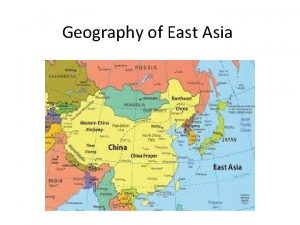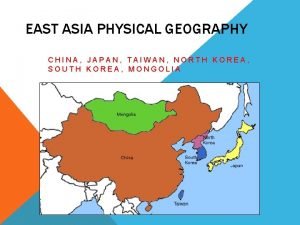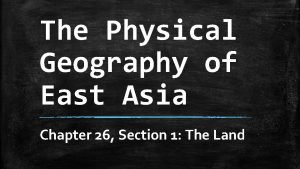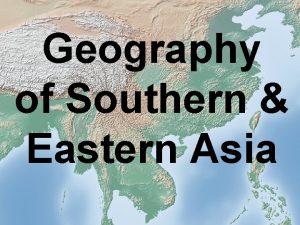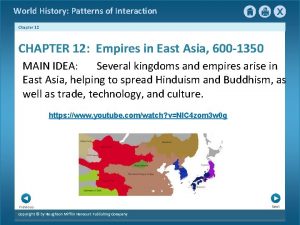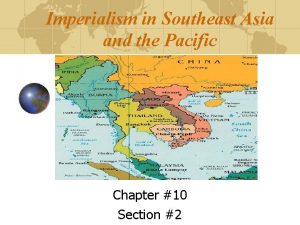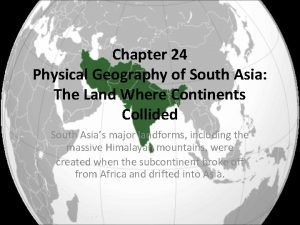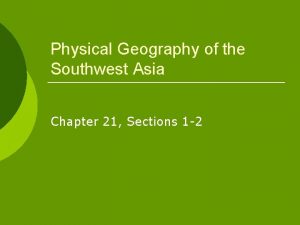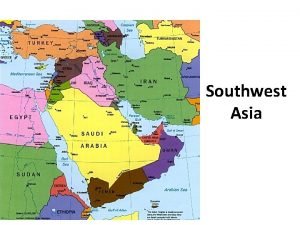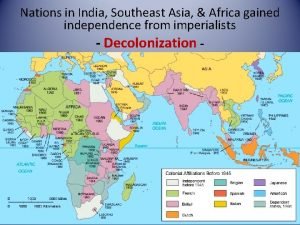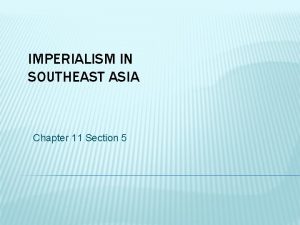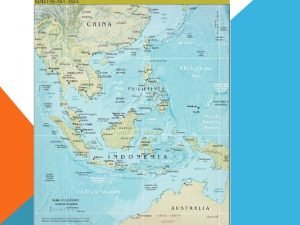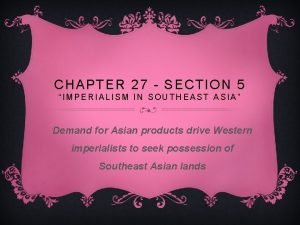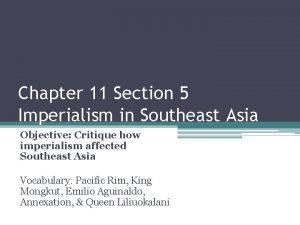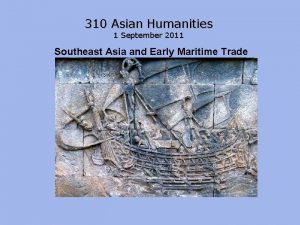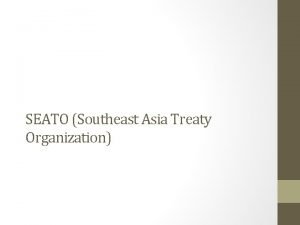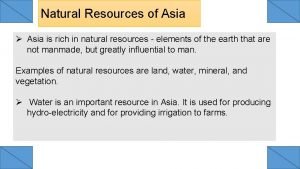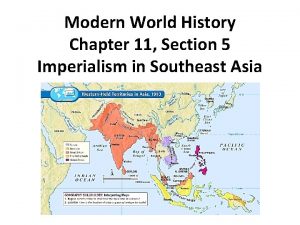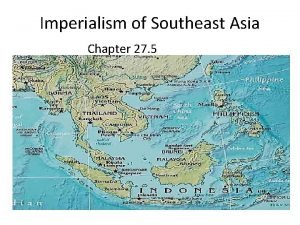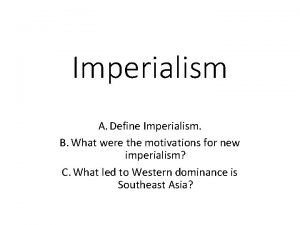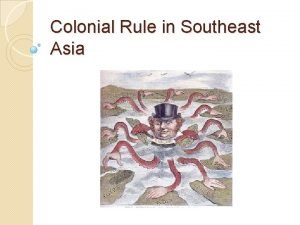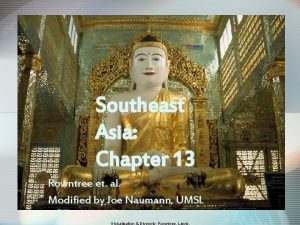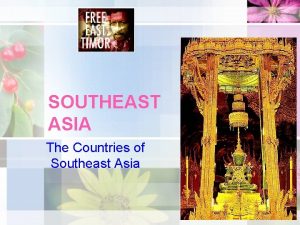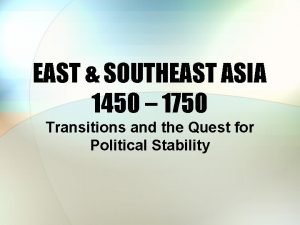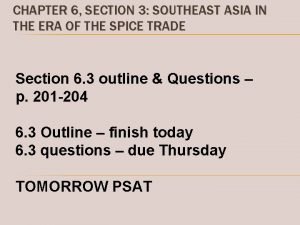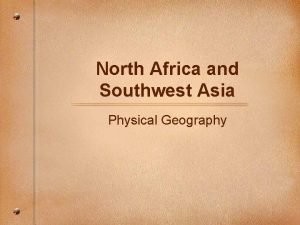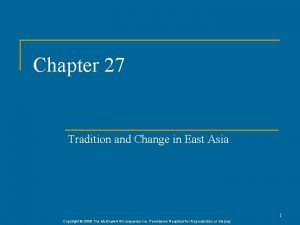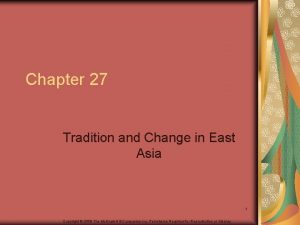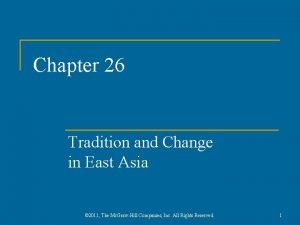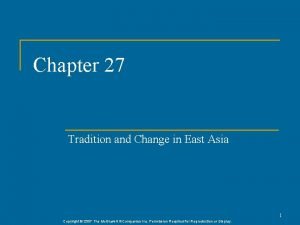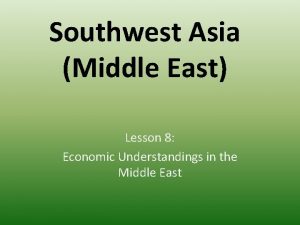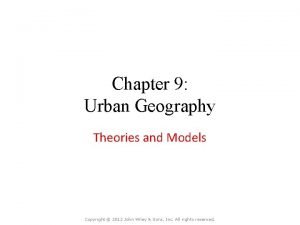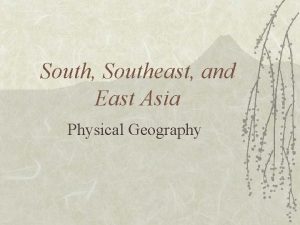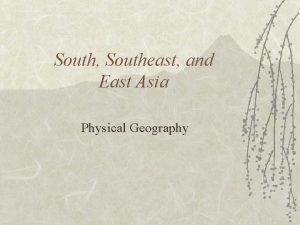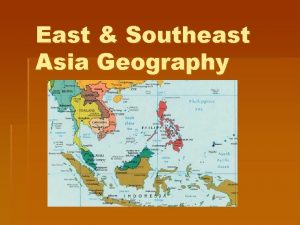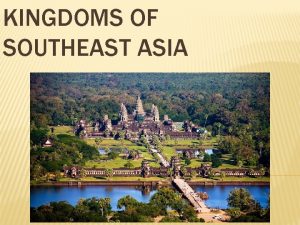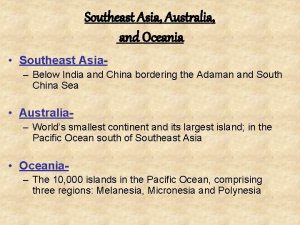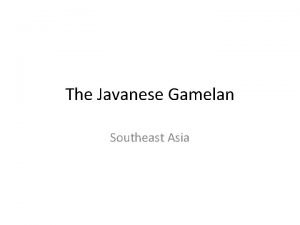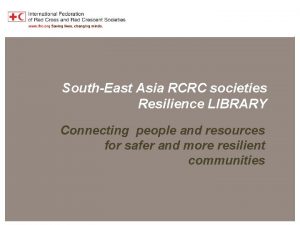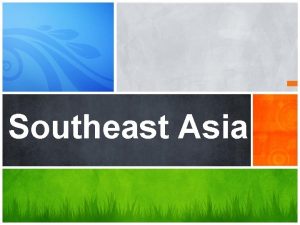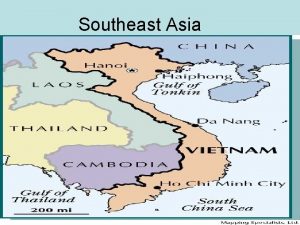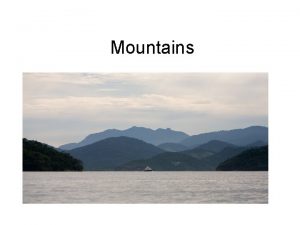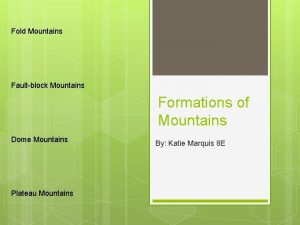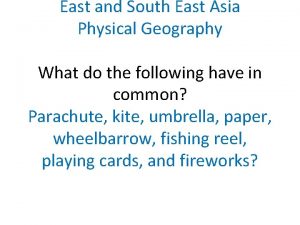Southeast and East Asia Physical Geography Mountains v














































- Slides: 46

Southeast and East Asia Physical Geography

Mountains v A. B. C. Mountains are important in Asia because they influence: Population patterns Movement of people and goods Climate

Mountains The most important mountain range in Asia is the Himalaya Mountains. v The Himalayas separate India from China. v The Himalayas block clouds that are formed by monsoons from entering Western China. v The Himalayas isolate Tibet and make transportation difficult. v



Mountains v A. B. C. D. Some other mountains in Asia are: The Hindu-Kush The Eastern and Western Ghats in India The Tian Shan Mountains Mount Fuji in Japan

Mountains v Mount Fuji is the tallest mountain in Japan at 12, 388 ft. The mountain is located on the island of Honshu and it is considered sacred by Shintos.


http: //www. youtube. com/watch? v=7 a. Nz. LPKCg. QI

Plateaus and Uplands Most of Western China is on a plateau called the Plateau of Tibet. Farther north is the Mongolian Plateau. v The Korean Peninsula and the Japanese Islands are mountainous. v

Rivers and Bodies of Water Many rivers in Asia start in the Himalaya Mountains. v Rivers erode away the mountains and carry sediment (little bits of dirt) down to the flat plains at the base of the mountains. v The sediment makes the soil by the rivers fertile and a good place to farm. v

The Rivers of China v China has three major rivers that begin in the Himalayas and flow into the East China Sea or Yellow Sea. River Chinese Name Yellow River Huang He Yangtze River Chang Jiang West River Xi Jiang

The Rivers of China v The Yangtze and Yellow Rivers flow through an area that is flat in elevation called the North China Plain. This area has intensive farming and the two rivers are connected by The Grand Canal. The type of dirt found here is called loess. It is a rich soil that is yellow in color and normally deposited by the wind.

The Yellow River

The Yellow River

The Rivers of China v The Amur River starts in the Great Khingan Mountains in Northern China and empties into the Sea of Japan. This river is also a border between China and Russia.

Rivers in Southeast Asia v The longest river in Southeast Asia is the Mekong River. This river starts in the Himalayas and flows through China, Laos, Cambodia, and Vietnam before emptying into the South China Sea.

Bodies of Water v Asia is surrounded by bodies of water. One important body of water is the Sea of Japan. It is located between the Korean Peninsula and Japan. In Korea they refer to it as the East Sea.

The Gobi Desert The largest desert in this area is the Gobi Desert. v The Gobi Desert is formed by orographic precipitation. South Asia gets rain from the monsoons but the Himalaya Mountains block the rain from entering Western China. Most of Western China and Mongolia are in a rain shadow. v

Islands v A. B. C. A group of islands is called an archipelago. There are many archipelagoes in Asia such as: Japan Philippines Indonesia



Other Islands v Some other islands in Asia are: A. Hainan B. Taiwan C. Sri Lanka D. Singapore E. Hong Kong

Taiwan is a large island off of the coast of China. Taiwan used to be called Formosa by the Portuguese. v The Democratic Republic of China is a country that is on the island. Some people just call the country Taiwan in order to avoid confusion. v

Singapore v Singapore is an island at the tip of the Malay Peninsula. The country of Singapore is located on the island it has become very wealthy because it is on a strategic waterway, The Strait of Malacca.

Hong Kong v Hong Kong is an island off of the coast of China. It was ruled by the British but now it is part of China.

Natural Hazards v A. B. C. The natural hazards that are found in Asia are: Monsoons Typhoons (Cyclones) Volcanoes and Earthquakes

Monsoon v A monsoon is a seasonal wind that occurs in South and Southeast Asia. During the summer monsoon wind blows from south to north. The wind pushes clouds over South and Southeast Asia causing rain.



Typhoon v Typhoons or cyclones are tropical storms that occur in the Pacific Ocean. In the northern hemisphere they rotate clockwise. In the southern hemisphere they rotate counter clockwise. These storms cause enormous damage in coastal areas and countries with low elevations.

Ring of Fire v Part of Asia is on The Ring of Fire, an area around the Pacific Ocean where many tectonic plates meet. This area is at a greater risk for having earthquakes and active volcanoes.


Climate and Vegetation v Asia has varied climate regions because: A. Zones of latitude - Part of Asia is in the low latitudes and part of it is in the middle latitudes. B. Elevation - Mountainous regions in Asia have colder climates. C. Topography - Mountains block rainfall causing deserts on one side.

Climate and Vegetation v Part of Asia is in the low latitudes otherwise known as the tropics. These areas have tropical wet or tropical wet and dry climates. What countries are in this area? A. Southern part of India and Bangladesh B. Myanmar, Thailand, Laos, Cambodia, Vietnam C. Indonesia, Malaysia, Singapore, Philippines

Climate and Vegetation v Tropical wet climate zones always have tropical rainforests. One problem in many parts of Asia is deforestation.

Climate and Vegetation v China, Korea, Japan, Taiwan, and parts of India are in the middle latitudes. Many of these areas have a humid sub-tropical or humid continental climate. Most of Western China is a desert.


Climate and Vegetation v Most of Northern Japan has a humid continental climate zone. This climate zone can also be found in Maine and New Hampshire. The winters are cold and it snows. http: //www. youtube. com/watch? v=590_mh. Au. Zhc

Climate and Vegetation v Part of Mongolia is a desert and part of it is covered by steppe.

Culture Introduction – East Asia is the most populous region in the world – China is the most populous country, and the oldest continuous national culture – Eastern China is undergoing rapid economic development – China and Japan have been rivals from time to time – East Asia has experienced colonization, and has seen both internal and international conflict – Japan is extremely wealthy, but poverty may be found in parts of the region – East Asia is one of the core areas of the world economy and an emerging center of political power

Economics JAKOTA TRIANGLE – JApan south KOrea & TAiwan

China’s Isolation – Natural protective barriers – Distance – Inward looking (central kingdom) with minor incidences of cultural diffusion – Effects of one ocean • A history of emperors who restricted use of the coastline, except in local circumstances • Today the ocean is playing a major role in the economic (and cultural) transformation of coastal China.

Three Gorges Controversy v Flooding, Dam-Building, and Related Issues – China’s Yangtze River is an important resource (3 rd largest volume) – The Three Gorges Controversy • Chinese government wants to dam the Yangtze (Chang Jiang) River with the largest hydroelectric dam in the world – Purpose: control floods & generate electricity – Problems: Will jeopardize animal species, flood a major scenic attraction, and displace up to 2 million people

v Three Gorges Dam Under Construction

 Lesson 1 physical geography of southeast asia
Lesson 1 physical geography of southeast asia Geography of asia
Geography of asia Taiwan physical geography
Taiwan physical geography China population density
China population density Physical geography of east asia
Physical geography of east asia Southern and eastern asia physical features answer key
Southern and eastern asia physical features answer key Kums definition geography
Kums definition geography Mainland se asia
Mainland se asia Chapter 12 section 5 kingdoms of southeast asia and korea
Chapter 12 section 5 kingdoms of southeast asia and korea Imperialism in southeast asia and the pacific
Imperialism in southeast asia and the pacific Climate zones of asia
Climate zones of asia Chapter 21 physical geography of southwest asia
Chapter 21 physical geography of southwest asia Chapter 21 physical geography of southwest asia
Chapter 21 physical geography of southwest asia Physical geography of middle east
Physical geography of middle east African coty model
African coty model Southwest asia landforms
Southwest asia landforms Is india southeast asia
Is india southeast asia Chapter 11 section 5 imperialism in southeast asia
Chapter 11 section 5 imperialism in southeast asia Mon khmer
Mon khmer Chapter 11 section 5 imperialism in southeast asia
Chapter 11 section 5 imperialism in southeast asia Chapter 25 lesson 4 imperialism in latin america
Chapter 25 lesson 4 imperialism in latin america Chapter 11 section 5 imperialism in southeast asia
Chapter 11 section 5 imperialism in southeast asia Southeast asian alphabets
Southeast asian alphabets Ramon magsaysay seato
Ramon magsaysay seato Natural resources in southeast asia
Natural resources in southeast asia Chapter 11 section 5 imperialism in southeast asia
Chapter 11 section 5 imperialism in southeast asia Imperialism in southeast asia chapter 27 section 5
Imperialism in southeast asia chapter 27 section 5 What led to western dominance in southeast asia?
What led to western dominance in southeast asia? Colonial rule in southeast asia
Colonial rule in southeast asia Chartch
Chartch Weaving the web of an indian ocean world
Weaving the web of an indian ocean world Countries in southeast asia
Countries in southeast asia Countries in southeast asia
Countries in southeast asia Southeast asia customs lawyers
Southeast asia customs lawyers Insular southeast asia
Insular southeast asia Southeast asia 1450 to 1750
Southeast asia 1450 to 1750 In 1500 mainland southeast asia was a relatively
In 1500 mainland southeast asia was a relatively North africa and southwest asia mountains
North africa and southwest asia mountains Chapter 27 tradition and change in east asia
Chapter 27 tradition and change in east asia Chapter 27 tradition and change in east asia
Chapter 27 tradition and change in east asia Chapter 26 tradition and change in east asia
Chapter 26 tradition and change in east asia Chapter 27 tradition and change in east asia
Chapter 27 tradition and change in east asia Lesson 8 middle east and south asia
Lesson 8 middle east and south asia Products of the southeast
Products of the southeast Southeast asian city model definition ap human geography
Southeast asian city model definition ap human geography East is east and west is west
East is east and west is west The southeast region of the united states of america
The southeast region of the united states of america

